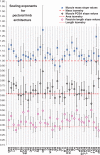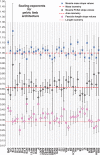Functional specialization and ontogenetic scaling of limb anatomy in Alligator mississippiensis
- PMID: 20148991
- PMCID: PMC2849521
- DOI: 10.1111/j.1469-7580.2009.01202.x
Functional specialization and ontogenetic scaling of limb anatomy in Alligator mississippiensis
Erratum in
- J Anat. 2011 Oct;219(4):542-7
Abstract
Crocodylians exhibit a fascinating diversity of terrestrial gaits and limb motions that remain poorly described and are of great importance to understanding their natural history and evolution. Their musculoskeletal anatomy is pivotal to this diversity and yet only qualitative studies of muscle-tendon unit anatomy exist. The relative masses and internal architecture (fascicle lengths and physiological cross-sectional areas) of muscles of the pectoral and pelvic limbs of American alligators (Alligator mississippiensis Daudin 1801) were recorded for an ontogenetic series of wild specimens (n = 15, body masses from 0.5 to 60 kg). The data were analysed by reduced major axis regression to determine scaling relationships with body mass. Physiological cross-sectional areas and therefore muscle force-generating capacity were found to be greater in the extensor (anti-gravity) muscles of the pelvic limb than in the pectoral limb, reflecting how crocodylians differ from mammals in having greater loading of the hindlimbs than the forelimbs. Muscle masses and architecture were generally found to scale isometrically with body mass, suggesting an ontogenetic decrease in terrestrial athleticism. This concurs with the findings of previous studies showing ontogenetic decreases in limb bone length and the general scaling principle of a decline of strength : weight ratios with increasing size in animals. Exceptions to isometric scaling found included positive allometry in fascicle length for extensor musculature of both limbs, suggesting an ontogenetic increase in working range interpreted as increasing postural variability - in particular the major hip extensors - the interpretation of which is complicated by previous described ontogenetic increase of moment arms for these muscles.
Figures




References
-
- Alexander RMcN. Allometry of the limbs of antelopes (Bovidae) J Zool. 1977;183:125–146.
-
- Alexander RMcN. The maximum forces exerted by animals. J Exp Biol. 1985;115:231–238. - PubMed
-
- Alexander RMcN, Jayes A. A dynamic similarity hypothesis for the gaits of quadrupedal mammals. J Zool (Lond) 1983;201:135–152.
-
- Alexander R, Ker R. The architecture of leg muscles. In: Winters J, Woo S, editors. Multiple Muscle Systems: Biomechanics and Movement Organization. Berlin: Springer; 1990. pp. 568–577.
-
- Alexander RMcN, Jayes AS, Maloiy GMO, et al. Allometry of the leg muscles of mammals. J Zool. 1981;194:539–552.
Publication types
MeSH terms
Grants and funding
LinkOut - more resources
Full Text Sources

